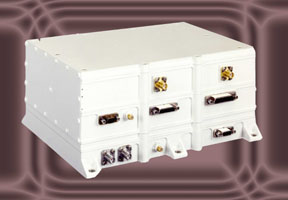Keeping Communication Continuous
General Dynamics Decision Systems employees have played a role in supplying telemetry, tracking, and control (TT&C) and other communications systems to NASA and the U.S. Department of Defense for over 40 years. Providing integrated communication systems and subsystems for nearly all manned and unmanned U.S. space flights, the heritage of this Scottsdale, Arizona-based company includes S-band transceivers that enabled millions of Americans to see Neil Armstrong and hear his prophetic words from the Moon in 1969. More recently, Decision Systems has collaborated with NASA's Goddard Space Flight Center to develop transponders, wireless communications devices that pick up and automatically respond to an incoming signal, for NASA's Tracking and Data Relay Satellite System (TDRSS).
Four generations of Decision Systems' TDRSS transponders have been developed under Goddard's sponsorship. The company's Fourth Generation TDRSS User Transponder (TDRSS IV) allows low-Earth-orbiting spacecraft to communicate continuously with a single ground station at White Sands, New Mexico, through a constellation of geostationary relay satellites positioned at key locations around the Earth. In addition to the communications of forward link control commands and return link telemetry data, the TDRSS IV also supports spacecraft orbit tracking through coherent turn-around of a pseudo-noise ranging code and two-way Doppler tracking.
Up until now, the highly successful relationship between Goddard and Decision Systems had produced a high quality product used primarily for NASA-specific programs. This changed when the National Scientific Balloon Facility (NSBF), in Palestine, Texas, turned to Decision Systems in need of a TT&C communications system for its high-altitude, long-duration balloon mission program.
Because many of the NSBF's balloon missions are flown at the Earth's poles, where commercial communications services are not readily available, the continuous communications feature provided by NASA's TDRSS is extremely important during a long mission. When the NSBF adopted the use of global positioning system receivers for balloon position tracking, Decision Systems concluded that a simpler, noncoherent transceiver could provide the NSBF with the necessary TDRSS communications without the additional cost and complexity of a coherent transponder. The solution was to take the core design of the TDRSS IV Transponder, but remove the extra functionality that supported coherent turn-around. This would simplify the production effort, reduce the testing required, and result in a lower cost product with smaller size, weight, and power consumption.
Once NSBF and Decision Systems agreed on a concept for this new product, known as the Multi-Mode Transceiver (MMT), the NSBF approached Goddard for approval and funding. The expertise and cooperation of Goddard engineers was critical during the test and evaluation phase of the devices production process, and the first MMT underwent TDRSS compatibility testing at Goddard before any of the commercial production units could be delivered.
With the new MMT's reduced size, weight, power consumption, and cost, the advantages of TDRSS communications are now available for a variety of applications outside of the traditional NASA spacecraft missions. With the MMT, the NASA system is now accessible to university satellite programs, small commercial Earth imaging programs, as well as Arctic and Antarctic science programs.

The Multi-Mode Transceiver brings the advantages of NASA’s Tracking and Data Relay Satellite System to a variety of applications, including university satellite programs, small commercial Earth imaging programs, and Arctic and Antarctic science programs.













